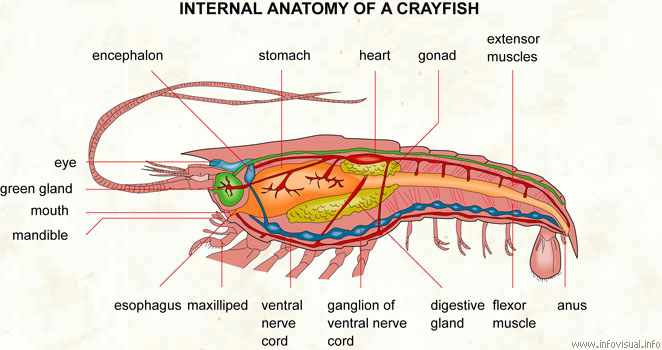what other structures help to digest food in the crayfish
Internal anatomy of a crayfish

Internal anatomy of a crayfish: edible freshwater crustacean, with pincers on the two forelegs.
Encephalon: site of the mental functions of a crayfish.
Tum: role of the digestive tract between the esophagus and the intestine.
Heart: blood-pumping organ of the crayfish.
Gonad: sex gland of a crayfish.
Extensor muscles: muscle that extends the tail of the crayfish.
Anus: outlet of the digestive tract.
Flexor muscle: muscle that bends the tail of the crayfish.
Digestive gland: glandular organ that produces digestive enzymes.
Ganglion of ventral nerve string: budge related to a collection of fretfulness of the abdomen of a crayfish.
Ventral nerve cord: collection of nerves in the abdomen of a crayfish.
Maxilliped: pair of appendages of a crayfish used for property prey.
Esophagus: part of the digestive tract between the rima oris and the stomach.
Mandible: lower jaw.
Mouth: entrance to the digestive tract.
Dark-green gland: antennary gland.
Eye: sight organ of a crayfish.
Photograph :
EN : Scorpion
FR : Scorpions
ES : Scorpiones

A Scorpions are eight-legged carnivorous arthropods. They are members of the order Scorpiones inside the course Arachnida. At that place are about 2,000 species of scorpions, found widely distributed south of near 49° N, except New Zealand and Antarctica. The northernmost part of the world where scorpions alive in the wild is Sheerness on the Isle of Sheppey in the Uk, where a pocket-sized colony of Euscorpius flavicaudis has been resident since the 1860s. The body of a scorpion is divided into two parts: the cephalothorax (also called the prosoma) and the abdomen (opisthosoma). The abdomen consists of the mesosoma and the metasoma. Scorpions take quite variable lifespans and the bodily lifespan of most species is non known.
The historic period range appears to be approximately 4-25 years (25 years being the maximum reported life span in the species Hadrurus arizonensis). Lifespan of Hadogenes species in the wild is estimated at 25-xxx years. Scorpions prefer to live in areas where the temperatures range from 20°C to 37°C (68°F to 99°F), but may survive from freezing temperatures to the desert oestrus. Scorpions of the genus Scorpiops living in high Asian mountains, bothriurid scorpions from Patagonia and small Euscorpius scorpions from middle Europe can all survive wintertime temperatures of near -25°C. They are nocturnal and fossorial, finding shelter during the 24-hour interval in the relative cool of clandestine holes or undersides of rocks and coming out at nighttime to hunt and feed. Scorpions exhibit photophobic behavior, primarily to evade detection past their predators such as birds, centipedes, lizards, mice, possums, and rats.
Scorpions are opportunistic predators of small arthropods and insects. They employ their chelae (pincers) to take hold of the prey initially. Depending on the toxicity of their venom and size of their claws, they will and then either vanquish the casualty or inject information technology with neurotoxic venom. This will kill or paralyze the casualty so the scorpion can consume information technology. Scorpions have a relatively unique manner of eating using chelicerae, small claw-similar structures that beetle from the oral cavity that are unique to the Chelicerata amid arthropods. The chelicerae, which are very sharp, are used to pull minor amounts of food off the prey item for digestion. Scorpions tin can only digest food in a liquid grade; any solid matter is tending of by the scorpion.
All scorpion species possess venom. In general, scorpion venom is described as neurotoxic in nature. 1 exception to this generalization is Hemiscorpius lepturus which possesses cytotoxic venom. The neurotoxins consist of a diversity of small-scale proteins that affect neuronal ion channels responsible for action potentials, which serve to interfere with neurotransmission in the victim. Scorpions utilize their venom to impale or paralyze their casualty so that it tin can be eaten; in full general it is fast-acting, allowing for constructive prey capture. The effects of the sting can be severe.
Scorpion venoms are optimized for action upon other arthropods and therefore most scorpions are relatively harmless to humans; stings produce only local effects (such as pain, numbness or swelling). A few scorpion species, however, more often than not in the family Buthidae, can be unsafe to humans. Amongst the most dangerous are Leiurus quinquestriatus, otherwise ominously known equally the deathstalker, which has the most potent venom in the family, and members of the genera Parabuthus, Tityus, Centruroides, and particularly Androctonus, which also have powerful venom. The scorpion which is responsible for the most homo deaths is Androctonus australis, or the yellow fatty-tailed scorpion, of Northward Africa. The toxicity of A. australis'southward venom is roughly half that of L. quinquestriatus, but despite a common misconception A. australis does non inject noticeably more venom into its prey. The higher death count is just due to its existence establish more commonly, especially nigh humans. Human deaths usually occur in the young, elderly, or infirm; scorpions are more often than not unable to evangelize enough venom to kill healthy adults. Some people, however, may exist allergic to the venom of some species. Depending on the severity of the allergy, the scorpion'south sting may cause anaphylaxis and decease. A master symptom of a scorpion sting is numbing at the injection site, sometimes lasting for several days. Scorpions are by and large harmless and timid, and only voluntarily use their sting for killing prey, defending themselves or in territorial disputes with other scorpions. Generally, they will run from danger or remain however.
Source: https://infovisual.info/en/biology-animal/internal-anatomy-of-a-crayfish
0 Response to "what other structures help to digest food in the crayfish"
Post a Comment